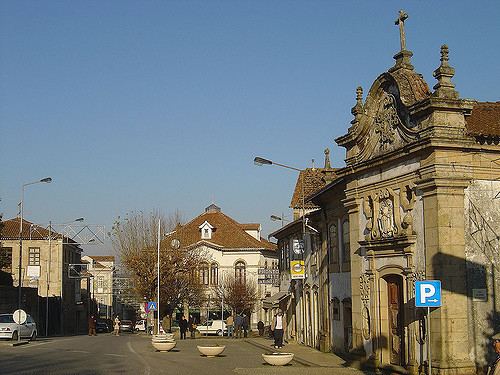Area 371.2 km² Postal code 3464 | Region Centro Parishes 19 Population 28,946 (2011) Local time Sunday 9:44 PM | |
 | ||
Weather 11°C, Wind S at 6 km/h, 84% Humidity | ||
Tondela ([tõˈdɛlɐ]) is a municipality in the central Portuguese subregion of Dão-Lafões. The population in 2011 was 28,946, in an area of 371.22 km².
Contents
Map of Tondela, Portugal
History
Amadeu Ferraz de Carvalho (1876-1951) wrote of the municipality of Tondela in the following terms: "The municipality of Tondela extends over the plateau, covers part of the eastern slope of Caramulo and surpassing the saw still slopes through the highlands of São João do Monte, over the gentle flanks of the upper Águeda basin. In this way, the natural sections of your area are: part of the plateau, cut by the Dão and its effluents the Pavia and Dinha; the depressed lands between the plateau and the Serra do Caramulo, drained by the Criz and its effluents; a part of the eastern flanks of the Caramulanian mountains and elevated east around the Águeda basin; and I add, an extreme basin, with Quaternary deposits, that indicate small extinct lakes, along the Serra do Caramulo; and the Vale de Besteiros." In this context, the region of Tondela appears as one of the principal locations of archaeological remnants, and concentrations of prehistoric populations.
The traditional origin of Tondela arises from the fountain Chafariz das Sereias, a sculpted spring of stone, with a woman holding a trumpet. Legend suggests that this female figure was representative another woman who monitored the movements of Moorish forces across the mountains from her lookout. When she discovered an impending attack from her vantage point the woman would sound the horn, and "at the sound of this instrument" (literally, tone of it), the settlers would arise to meet the enemy. The phrase "ao'tom'dela", which means "the sound of it", was transformed into the name "Tondela".
Documents from the 9th, 10th and 12th century designated this region as the Terra de Balistariis. This designation arises from the word balista or besta, a war machine used by besteiros during the Middle Ages.
The current municipality was actually the seat, until 1836, of the historical municipality of Besteiros, whose name continues to be seen in some of the historical documents, references and coat-of-arms of Tondela. To this former administrative division were annexed, through successive administrative reforms, including the older entitites of Serra do Caramulo, São João do Monte and Guardão. Also, the lowlands, such as Mouraz, Sabugosa, Canas de Santa Maria, São Miguel de Outeiro and a few parishes that were part of Viseu or the smaller municipalities of Barreiro and Treixedo were extended into Tondela.
Geography
Administratively, the municipality is divided into 19 civil parishes (freguesias):
Sport
The Clube Desportivo de Tondela is the main sports club in the municipality, and its football team earned its first ascension to the First League Primeira Liga, during the 2015-2016 season, playing side-by-side with teams such as FC Porto, SL Benfica and Sporting CP.
